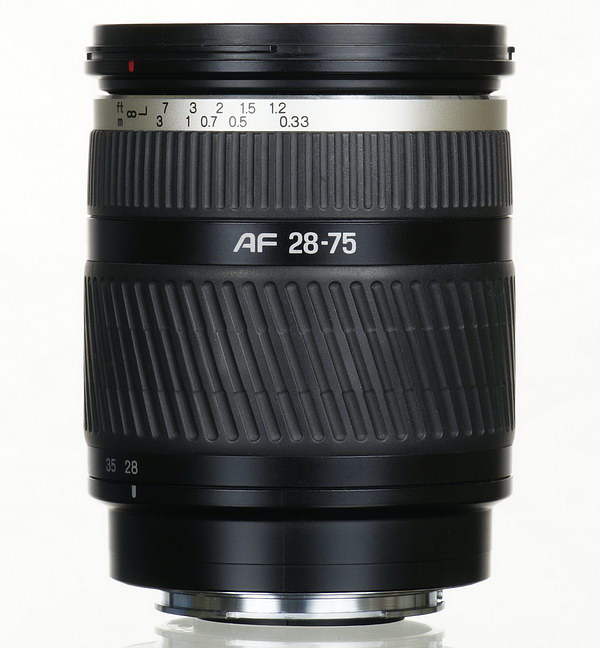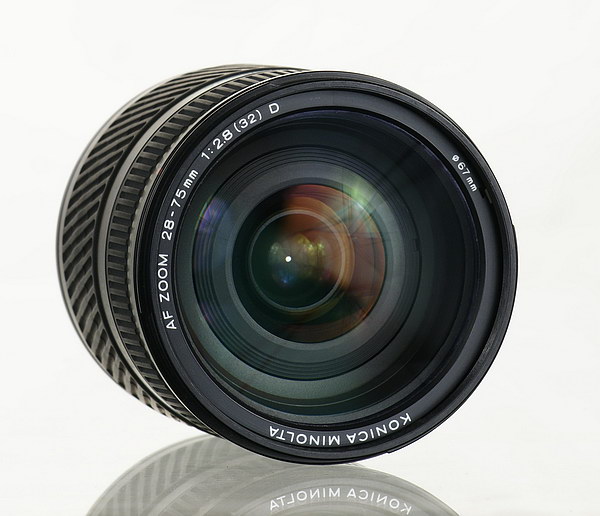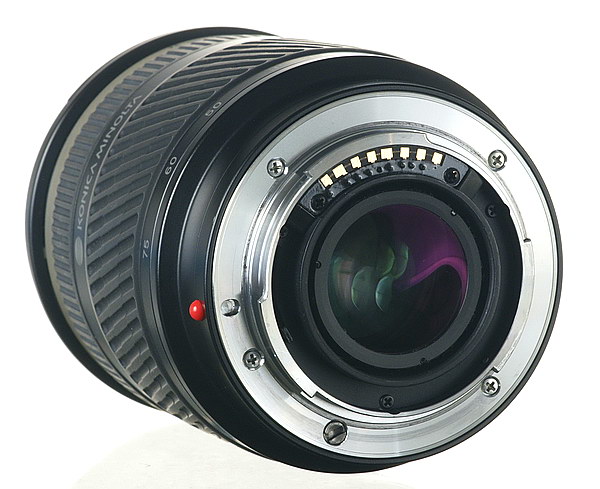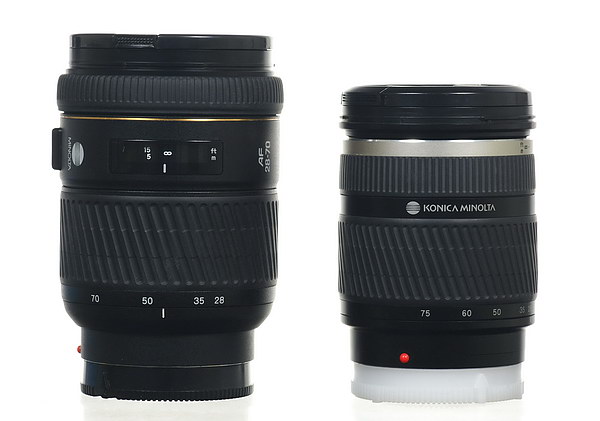Here’s a brief look at the Konica Minolta AF 28-75mm F/2.8 (D) zoom lens. Scroll down for the main review.
|
Lens
|
Konica Minolta AF 28-75mm F/2.8 (D)
|
|
Box contents
|
Front and rear caps, hood and users manual.
|
|
Cost
|
|
|
Build quality
|
Good
|
|
Additional information
|
|
Specifications below
|
|
|
Optical configuration
|
16 elements in 14 groups
|
|
Angle of view
|
75°-32° full frame, 54°-21° APS-C.
|
|
Aperture
|
7 blades, circular
|
|
Full frame and APS-C
|
Yes, full frame and APS-C. APS-C equivalent, 42-112.5mm
|
|
Depth of field and focus scales?
|
Focus distance scale.
|
|
Minimum focus, image plane to subject
|
13″ (330mm)
|
|
Minimum focus, end of lens barrel to subject
|
5.8″ (147mm)
|
|
Hard stop at infinity focus?
|
No
|
|
Length changes when focusing?
|
No
|
|
Focus ring turns in AF?
|
Yes
|
|
Filter size
|
67mm
|
|
Filter ring rotates?
|
No
|
|
Distance encoder?
|
Yes
|
|
Max magnification
|
0.26x
|
|
Min. F/stop
|
F/32
|
|
Sony teleconverter compatible?
|
No
|
|
Length changes when zooming?
|
Yes
|
|
Dimensions WxL (my measurements)
|
2.9″ x 3.7″ 73mm x 94mm
|
|
Maximum extended length (my measurements)
|
5.0″ (128mm)
|
|
Weight bare (my scale)
|
17.9oz (508g) 18.9oz (535g) with caps
|
 |
| Box and contents |
 |
| Side shot fully drawn in |
 |
| Side shot fully extended |
 |
| Front element. |
 |
| Backside. |
 |
| Comparison to the Minolta AF 28-70 F/2.8 G (on left) |
The
Sony A700 and
Sony A900 were used for this review. For full frame results, go to the bottom of the page. For a better understanding of my review methods and terminology,
go here.
The (made in China) Konica Minolta AF 28-75mm F/2.8 is a less expensive alternative to the well built Minolta AF 28-70mm F/2.8 G.
This wide to medium range zoom is fairly light, and handles well for the most part. It has a constant fast aperture of F/2.8 and uses an internal focus design and extending zoom, see images above. Currently, Sony has a fast lens covering the same basic range as this one, the Carl Zeiss 24-70mm F/2.8, though it’ll cost you three times as much. The color and texture of the Konica Minolta matches the Sony lenses, but the rubber around the zoom and focus rings looks different. I like the Konica Minolta rubber better, as it’s easier to wipe off than the closely ribbed rubber of the new Sony lenses. The EXIF data matches up with the focal length marks, which come at 28mm, 35mm, 50mm, 60mm, and 75mm. Increments are 5mm apart (after 30mm) in the data, but 65mm is missing, that’s the way it is. There are no fancy focus lock buttons or limiter switches for you to play with. The lens is multi-coated with the magenta/green look typical for Minolta the past 10 years. Konica Minolta claims the use of 3? aspherical, and ? anomalous dispersion (ED) elements in the construction of the lens.
Zooming is easy, and as a consequence, zoom creep is a problem at 28mm. If you tilt the lens down, it runs out to 35-50mm. The Tamron version of this lens has a zoom lock switch.
Auto-focusing is quick and fairly quiet, much better than the more expensive Minolta 28-70mm F/2.8 G lens. It seems pretty accurate, I had no problems with locking focus at F/2.8 in poor light. Manual focusing takes just over 1/6 of a turn from Close-in to infinity, with no back slop. This lens has a reversed focus rotation, the same as the 18-200mm and 18-250mm lenses.
Lens flare/ghosting. Decent, to not very good. Check out the samples below. If the sun is near the image, you’ll need to block it with your hand. If you like taking pictures with the sun in the image, use the Sony kit lens, which has the best control of flare and ghosting of any zoom I’ve tested. This lens comes with a petal type lens hood, but you need to use your hand for best results, especially at the wide end. This lens performed better with the sun in, or near the image than the Minolta AF 28-70mm F/2.8 G.
Color fringing. Very good control here, one of the best lenses in the Minolta/Sony lineup.
Bokeh. Good at normal viewing sizes, see crops below. Blur is best wide open, but has an inner circle and is more harsh as you stop down.
Color. Similar to other Minolta AF lenses.
Coma. Extremely light at F/2.8, gone by F/4.
Close-up filter. N/A.
Filter size is 67mm. This is an odd-ball size, and is used on only one Sony lens, the similar 28-75mm F/2.8 SAM.
Distortion. See below. Moderate barrel at 28mm. Distortion is flat at 35mm, then turns to mild/moderate pincushion. Average control here.
Distortion examples
 |
| 28mm, moderate barrel distortion. |
 |
| Moderate pincushion at 75mm. |
|
Ghosting and flare, 28mm F/5.6
|
Sun in picture shot, 28mm F/5.6
|
|
|
|
|
Bokeh, 28mm F/2.8
|
Bokeh, 28mm F/4
|
|
|
|
|
Bokeh, 75mm F/2.8
|
Bokeh, 75mm F/4
|
|
|
|
Full image extreme examples of flare/ghosting above. Control is fair at all focal lengths. In the top left shot the sun was just outside the frame, and sun flare is strong. With the sun at a more centered position, the results are better, as the right shot shows. The “sun in picture” shot looks good in this tiny size, the green blob is but one ghost you can see among three that you can’t, you also can’t see a little washed out area by the bushes. All is not lost though, as this lens performs better than the
Minolta 28-70mm F/2.8 G, especially with the sun in the image. There is no ring present when the sun is centered like the Minolta G always shows.
Bokeh examples above, pretty smooth towards the wide end at F/2.8, then just ok as you zoom to 75mm. Blur gets a little harsh as you stop down. Overall, similar results to the Minolta AF 28-70mm F/2.8 G lens. Samples where taken from the central background area of the image and cropped at 100%.
Light fall-off.
Light fall-off or corner shading is very mild at F/2.8 from 28mm to 75mm. No problems on a cropped sensor camera, but see full frame results at the bottom of the page.
Center and corner sharpness.
Below are crops from the image centers at 28mm.
Now the 28mm corner crops.
|
28mm F/2.8
|
28mm F/4
|
|
|
|
|
28mm F/5.6
|
28mm F/11
|
|
|
|
The 28mm center crops show little improvement by stopping down, what you’re seeing at F/2.8 is a loss of contrast due to spherical aberration. By F/4 everything is as sharp as it gets, so that’s good. The 28mm corners are very soft wide open, and don’t sharpen up fully until F/11. I’ve omitted the F/8 results, but you can extrapolate the difference, which isn’t much. The sides of the frame are soft also, and sharpen up at F/5.6. Overall, the corners at wide angle don’t look very good, so remember to stop down hard if you’re taking landscape or architectural type shots.
Below, look at the 75mm centers.
|
75mm F/2.8
|
75mm F/4
|
|
|
 |
|
75mm F/2.8
|
75mm F/4
|
|
|
 |
On to the 75mm centers, where the results are pretty much the same as the wide angle shots, pretty sharp at F/2.8, then maybe a hair sharper one stop down, but only visible blown way up on a computer screen. You can see the spherical aberration at F/2.8 on the side of the A/C unit in both (F/2.8) shots, but there’s still a lot of detail present. Keep in mind the full images would print out at 45″ (1.14m) long as they appear in the crops using an A700. The corners really aren’t helped much by closing the aperture, and obviously don’t look as sharp as the centers.
Let’s check out the
macro capabilities of this lens.
Below, check out the sample, and click (335kb) to see a 100% cropped portion of the full image. The sample shot was taken with the
Sony A 700 12.2MP camera. The subject is a standard US stamp, 1″x 3/4″ or 25.4mm x 19mm. Also, note the macro shot was taken as close to the subject as focusing allowed; in this case 5.8″ (147mm), measured from the front of the lens barrel to the subject.
 |
| As close as you can get, F/11. |
The Konica Minolta AF 28-75mm F/2.8 has an excellent reproduction ratio of 0.26x, and it turned in a very good shot! It’s infinitely better at close reproduction than the .09x Minolta 28-70mm F/2.8 G. This shot was taken at F/11, but there was little difference between that and F/8.
Full frame results using the Sony A900 below.
Check out the differences when using a film or full frame camera below. I’m only pointing out the noticeable issues as compared to the APS-C bodies, so if I don’t show it here, the results are not significantly different enough to warrant posting an additional set of images in this section.
Light fall-off
|
28mm F/2.8
|
28mm F/4
|
 |
 |
|
28mm F/5.6
|
28mm F/8
|
|
|
|
|
75mm F/2.8
|
75mm F/4
|
|
|
|
Light fall-off is worse than the APS-C crops shown earlier. At 28mm, F/2.8 it shows a little heavy, but isn’t all that noticeable in real shots, see image below.
Full image from A900 below.
This full scene shows how the light fall-off from 28mm, F/2.8 isn’t as bad as the crops above show. As I’ve said before, you wouldn’t use F/2.8 in an outdoor, broad daylight scene anyhow! The small amount you see above is easily cleaned up with vignetting sliders in some photo editing software.
28mm corner samples next.
|
F/2.8
|
F/4
|
 |
 |
|
F/5.6
|
F/11
|
|
|
|
For some reason, there doesn’t seem to be much different between full frame and APS-C corner crops. Things sharpen up nicely at F/8, then max out at F/11, maybe one stop down from the APS-C crops. The centers of these crops are about 250 pixels from the image borders, which would darn near be covered up by a picture frame with a medium sized print. I’ve deliberately left out the F/8 shots again (here, and below), which don’t look quite as good as the F/11 shots. The exposure differences are from light fall-off.
75mm corners below.
|
F/2.8
|
F/4
|
 |
 |
|
F/5.6
|
F/11
|
|
|
|
The 75mm corners don’t change much, you mostly see the elimination of light fall-off. Things sharpen up a little as you stop down, though it seems there isn’t much point in stopping down. This is different in what we saw in the APS-C crops earlier. Such is the full frame predicament.
Distortion next.
 |
| Barrel distortion @ 28mm on A900 |
 |
| Pincushion distortion @ 75mm on A900 |
There is moderate barrel distortion at wide angle, and moderate to slightly heavy pincushion distortion as you zoom out. The barrel distortion signature resembles a “wave” and is a little harder to completely correct in post-processing. Overall, an average job at controlling distortion.
Coma results with full frame.
|
F/2.8
|
F/4
|
 |
 |
This is coma @ 28mm on the A900. It looks very similar to the Minolta AF 28-70mm F/2.8 G. It isn’t too bad at F/2.8, one stop down and it’s almost gone. It doesn’t clear up all that much as you zoom out, and results are mostly the same up to 35mm. Everything looks good from 50-70mm. The 100% crops in this A900 section are from the extreme corners and are a portion of the original image. Printing out the entire image as you might see it on your screen would measure 65″ (1.65m) wide using the A900!
|
Conclusion.
For APS-C users; the Konica Minolta AF 28-75mm F/2.8 lens performs very well in the centers at all focal lengths and apertures. Color fringing, coma and light fall-off are almost non-existent. There are some drawbacks to consider; the corners need to be stopped down for maximum sharpness. Figure on at least two stops at wide angle and one stop at the long end. Additionally, flare and ghosting are not very well controlled, so watch out when the sun is near the image, solve this by using your hand to block the light. When the sun is part of the image, try to have it centered. One more item, the image periphery can be soft unless stopped down hard, say F/5.6-F/8. The zoom range is equivalent to 42-112.5mm, not so great in my opinion. This lens tested very similar to the
Sigma 18-50mm F/2.8. The sigma has the equivalent range of 27-75mm, much more practical I think, and it may be a slightly better performer depending on Sigma quality control.
For full frame users; you’ll have the same basic problems with flare and ghosting, and more light fall-off. The corners need several stops adjustment to sharpen up, and the image periphery is not what it should be at the long end-meaning soft even at F/8. It definitely isn’t as sharp outside the center area as the Minolta AF 28-70mm F/2.8 G lens. If you really need to use F/2.8, want a smooth bokeh (at wide open aperture), and don’t have much money, this lens may fill your needs. It’s great for indoor events and people shots, and is currently selling for only half the cost of the
Minolta AF 28-70mm F/2.8 G. Also consider the new Sony 28-75mm F/2.8 SAM.













































